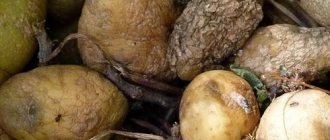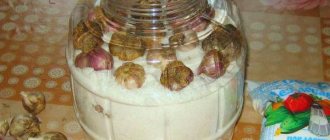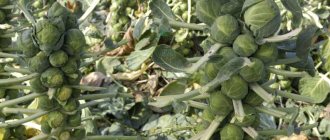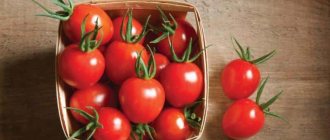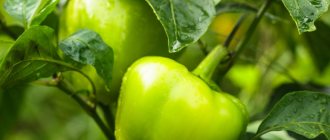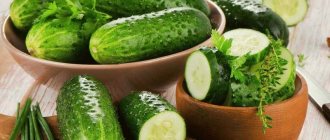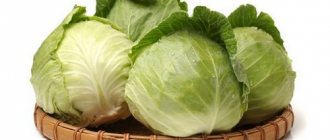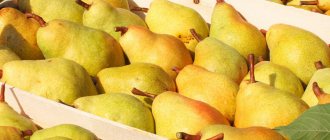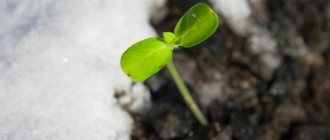How to store carrots in the cellar in winter?
It is best to store carrots by covering them with dry sand.
Carrots, despite all their hardness, are a very delicate vegetable. Since it does not have a thick skin, it reacts quite negatively to the most minimal temperature fluctuations. The optimal option for storing this root vegetable is a temperature of +1 and almost 90% air humidity in the room.
It is clear that it is almost impossible to create such conditions in the basement where, in addition to carrots, other vegetables will be stored, it would be better if you try to make a kind of protective shell for it.
Carrots can be stored in:
- Sawdust. They will create a layer that will restrain the flow of air to the root crop, and also protect it from cold and temperature fluctuations.
- Pesce. In this case, sand is also used as a layer, but the vegetables are laid in a completely different way. Carrots are placed in rows, forming a pyramid. Each individual row is covered with sand (the layer should be at least 1 cm) and sprinkled with a little water. With this storage method, it is extremely important to ensure that the vegetables do not touch each other.
- Clay. It is diluted with water to the consistency of thick sour cream, and then the root vegetable is dipped into the resulting slurry for a couple of seconds, the protective shell is allowed to dry and the whole thing is placed in a basket or wooden box.
Choosing a place
Choosing a suitable place for vegetable storage is not the easiest task. Its durability will depend on the soil on which the cellar is built.
Experts and experienced summer residents recommend starting construction on an elevated and dry place, as this will simplify the work with waterproofing.
If there is no suitable place, you can make a vegetable storage facility in any available area. The only mandatory condition is that the groundwater level does not reach the base of the building by 0.5 m. If the cellar is located in a damp and low-lying area, protect it with a layer of sand and gravel.
How to store beets in the cellar for the winter?
Conditions for storing beets for the winter
Beetroot categorically does not tolerate heat, so it must be stored at a temperature of no more than +2. If the temperature in the cellar rises above +5, the vegetable will begin to rapidly lose moisture and rot. In view of this, it is best to store beets and carrots in a protective shell.
Storage methods:
- Leaves of rowan, fern and wormwood . Place the beets in a wooden box and arrange them with the prepared leaves. With this storage method, your root vegetables will be protected not only from temperature fluctuations, but also from microflora that causes vegetables to rot. The leaves of these plants will secrete phytoncides all winter, which will kill pathogenic microorganisms.
- Salt. This product creates a protective shell that fights not only temperature, but also moisture. If you don't want to bother, then just sprinkle the beets with salt. But if you want it to last until the next harvest, then prepare a concentrated salt solution, dip the beets in it, wait until they are completely dry, and only then put them in a box.
Sanitation
If during an inspection of your future cellar you find mold or pests, be sure to take action. Long-term storage of crops in conditions of high humidity and unsanitary conditions is impossible. You can treat the room yourself or turn to professionals.
First, remove mold with a solution of copper sulfate or any specialized product. After this, remove all residues with a construction scraper. All you have to do is putty and paint the clean walls.
To combat rats or insects, use proven methods such as smoke bombs, traps, dusts and insecticidal solutions. You can find all these products in hardware stores. After all the pests have been exterminated, thoroughly clean the cellar.
If you have dealt with rodents, be sure to check the room for airtightness. Seal manholes and holes in ventilation with a mixture of glass wool and concrete. You can additionally coat them with clay on top.
Mold on the wall of the room.
Check the cellar every time before starting the next harvest. Clean, remove mold if necessary, and make minor repairs.
Of course, completing this step will take you a lot of time, but it will ensure the successful storage of your supplies. Since, in addition to fresh fruits, cuttings and seedlings are placed in vegetable storage facilities, the next harvest also depends on the thoroughness of processing.
How to store apples in the cellar in winter?
Apples in paper
- Most often, we put apples in the cellar while they are still greenish, and there they ripen and gain flavor. And since during the ripening process they begin to release a substance, ethylene, which causes all vegetables in the immediate vicinity to begin to germinate, it is better to store them away from the rest of the crop. If you do not have the opportunity to allocate a separate room for apples, then use our tips.
- First, make sure there is good ventilation in the room. This way, almost all the ethylene will be pumped out of the room, and the small part that will remain in it will no longer be able to cause much damage to your harvest.
- Secondly, try to create an airtight package for each apple separately. To do this, take paper (it can even be newspaper) and carefully wrap each fruit with it. Apples prepared in this way can be placed in wooden boxes or cardboard boxes.
Treating the basement (cellar) with disinfectant solutions
Whitewashing with fluff lime
When preparing the cellar and basement for winter, do not forget about the need to disinfect its walls, and the choice of treatment method depends only on the material from which the walls of the storage room are made. If the material is brick, then regular whitewashing can be done with a special solution prepared on the basis of lime with the addition of a 5% solution of copper sulfate. In the presence of wooden floors, a solution of 10% copper sulfate is used for treatment. The process of disinfecting a room is carried out using a regular roller or sponge, and a spray bottle is used for hard-to-reach places. After completing the procedures, thoroughly ventilate the cellar.
We use potassium permanganate
In the absence of lime whitewash, a strong solution of potassium permanganate or tobacco decoction can be used to treat the walls (5 tablespoons of tobacco dust are poured into 1 liter of water).
Sulfur checker
An old and proven method for disinfecting a cellar is to use sulfur to fumigate the room. Such work must be carried out in absolutely sealed conditions, otherwise all the work will be in vain. This method of disinfection requires strict compliance with safety precautions, since sulfur dioxide produced during the combustion of sulfur is poisonous to the human body.
We calculate their number
When calculating the amount of sulfur, it is necessary to take into account that approximately 40-60 grams of sulfur should be consumed for each cubic meter of room. The specified amount of this substance is poured onto a metal surface and burned, and all nooks and crannies are treated with the smoke generated during the combustion process. After disinfection in this way, the cellar is tightly closed for several hours, and after that they are thoroughly ventilated. It is necessary to resort to this method only if you have an isolated cellar, so if the vegetable storage is located in residential premises, and even with ventilation ducts, such disinfection will not be suitable.
How to use quicklime
A good way to get rid of harmful insects that entered the premises with the last harvest, as well as to remove mold and fungi, is this method: several kilograms of quicklime feed lime is poured into a container and filled with water. After this, it is urgently necessary to leave the room and create a seal for several days. After 1-3 days, it is necessary to carry out thorough ventilation, and to achieve complete disposal of pests, re-treat after a few days.
A simpler way to protect crops from rodents is to line boxes with collected fruits with bricks. This will help maintain the necessary humidity in the cellar, which will increase the shelf life of vegetables and fruits.
How to store zucchini for the winter in the cellar?
Zucchini on the shelf
Although zucchini is a very delicate product, you can still store it in the cellar for some time. For storage, it is best to choose winter varieties that have thick and hard skin.
Also keep in mind that in order for the zucchini to remain tasty and juicy for as long as possible, it must have a stalk. Therefore, when tearing a vegetable from the stem, be sure to leave the root at least 4 centimeters long.
You can store zucchini in:
- Grids . Take any small stack, put a zucchini in it and hang it from the ceiling. In this position, the vegetable will remain fresh for at least 4 months.
- Seine. Make a wooden rack in the cellar and line it with hay. Place the zucchini on top of it in neat rows, leaving a small distance between them.
How to store pumpkin for the winter in the cellar?
Storing pumpkins in the cellar
- Many people believe that pumpkin does not require any special storage conditions, so they simply lay it out on the floor of the cellar. But this vegetable, like zucchini, requires a more tender attitude. If you leave it lying on the floor, then literally in a month you will be able to see that it has begun to deteriorate.
- If you want to prepare healthy pumpkin dishes almost until next summer, then make sure that it has its own separate place in the cellar. The best option for storing pumpkins would be a wooden rack more than a meter high, covered with paper.
- The pumpkin must be placed in such a way that its stalks look up and its sides do not touch each other. If you know that the temperature in your cellar in winter can drop below zero, then additionally fill all the spaces between the pumpkins with straw or hay.
How to store potatoes in the cellar in winter?
Box for storing potatoes
Potatoes, like any other vegetable, react quite strongly to the most minimal changes in temperature and humidity in the room, so it is important to make sure that the cellar in which it will be stored is at least well ventilated. It is best to store this root vegetable at a temperature from +2 to +4 and at 70% humidity.
And if temperature indicators can still fluctuate in one direction or another, then you must monitor the humidity very carefully. If its indicators rise to at least 80%, then your crop will begin to become covered with rot.
It is best to store potatoes in:
- Grids. If you don’t have special boxes for storing potatoes, then the mesh is just what you need. It will allow air to circulate around the tubers all the time, helping to prevent them from getting wet and rotting.
- In bags. If you choose this particular storage method, then give preference to bags made from natural burlap. Unlike paper and polyethylene, they can protect your crop from both dampness and cold.
Vegetables in the cellar: traditions and know-how
When storing vegetables for the winter, many of us have to deal with the envious bewilderment of our neighbors: “You don’t want to bother with this cellar, you can buy everything in the store!” Not every house has a basement, and a cellar, especially a glacier, is not entertainment for everyone. But it absolutely justifies itself! The quality of vegetables from the store is often confusing: it is not known how they were grown, and under what conditions they were stored, or what chemicals were used. In addition, the costs of building and improving the cellar still pay for themselves.
SibirianBear FORUMHOUSE user
The price of groceries from the store already includes the rental fee for the store freezer. And if you provide for yourself, then a glacier will not be superfluous at all. I’ll tell you about volumes using my own example: now my family is 5 people, and I’m still young, full of energy and don’t plan to control the birth rate.
How to maintain a constant temperature in the cellar
Both old, ancient methods and new inventions will help you preserve freshly harvested vegetables in the cellar. The optimal storage environment for most vegetables is provided by maintaining the correct temperature (slightly higher than 0 degrees), high relative humidity (70-95%), good ventilation and air circulation, and the absence of light.
Therefore, it is necessary to constantly monitor the temperature and humidity of the air in the cellar, and if something happens, immediately lower it with the help of ventilation.
FORUMHOUSE user MalchishPlokhish installed a weather station with a remote sensor to control temperature and humidity in the cellar.
Malchish has a wonderful cellar: “brick, insulated, ventilated,” which consists of three rooms – two isolated and a walk-through, because “potatoes and apples should not be stored together.” The top of the cellar and its walls are insulated with extruded polystyrene foam, so everything is fine with humidity: there is no water on the ceiling or walls of the cellar, and there is enough natural ventilation.
Like most gardeners, MalchishPlokhish maintains a constant temperature in the cellar using a ventilation system. With closed ventilation, the temperature does not drop below +8 degrees, and most of the time the temperature in the cellar for storing vegetables should be much lower - the classic +2.5 degrees. I don’t want to run to the cellar every day and look at the thermometer. And I don’t want to install any weather-sensitive automation because of its unreliability. It’s easier to open and close the valve with your own hands several times during the winter in order to “lower the temperature,” especially since “the ventilation pipes will still be overgrown with frost, and they will have to be cleaned regularly.” The user of our portal is satisfied with the weather station with a sensor, which, by the way, is quite inexpensive.
MalchishBad: FORUMHOUSE user
It's -1 degrees outside, the door to the cellar has been wide open for a week. The cellar now shows +7 degrees, humidity 71%. There is a good alarm function when the set temperature, humidity and dew point are reached. I set the alarm to +2 and the humidity to 95%. Let's wait.
Many people are afraid of frost in the ventilation pipe. FORUMHOUSE user Volkodlak talks about a system that has long been used by cellar owners with engineering brains: they put a mesh in the ventilation pipe or screw screws so that they intersect. During severe frosts, iron (mesh cells or screws) become covered with frost. The stronger the frost, the more frost will grow, the correspondingly less air flow into the cellar will occur, and thus the ventilation will be controlled automatically.
System for maintaining constant temperature in the cellar
Many cellar owners eventually begin to think about glaciers. This is due to the desire to make the house as autonomous as possible, independent of purchased electricity. The glacier will allow you to preserve vegetables even in the summer heat.
Tatasun still has a functioning glacier in the village, built in 1925-1928. This is a free-standing log house, a low building measuring approximately 6x5 meters, most of which is dug into the ground. The log house is made of very thick logs with a diameter of 40-50 cm. At the end of winter, to maintain the desired temperature, large pieces of snow, cut from snowdrifts with a hacksaw, are brought into it annually. The snow is covered with a thick layer of straw on top, and there is also a thick layer of straw on the ceiling under the slate roof. Snow does not melt until winter and is used to preserve food.
How to store in a cellar
Potatoes
At first (from five days to two weeks), the potatoes need to lie in a cellar with good ventilation and relatively high humidity at a temperature of +10 - +18 degrees. These conditions are necessary for the tubers to ripen: the peel becomes rougher, the amount of vitamin C increases, and processes occur in which water-soluble carbohydrates become starch. Then, over the course of a month, the temperature in the cellar should gradually drop to +4 degrees or even slightly lower, depending on the type of potato. This temperature is maintained throughout the winter.
In the spring, the dormant period of the tubers ends, and to prevent them from germinating, it is important to prevent the temperature in the storage from rising. At this time, in order to maintain a low temperature in the cellar, it is ventilated only at night or on cold days. It’s great if you can transfer the potatoes to the glacier.
There are chemicals that help inhibit the germination of tubers and help them survive for a long time, but vegetable growers have an ambiguous attitude towards chemistry. The folk method is that if the cellar ventilation is poor, you can insulate the potatoes: cover the top with wood shavings, straw, or burlap. Agronomists say that potatoes are best preserved if they are covered with two or three layers of beets. The point of this event is this - beets are more resistant to disease than potatoes, so let the potatoes be at the bottom, and the sweating zone moves into the beets.
Beets, radishes, carrots
All root vegetables (except radishes), like potatoes, enter a dormant period when the storage temperature drops. Therefore, organizing their storage is quite simple. It is only important to guess the time of harvesting: before frost, because root crops caught by frost will inevitably become slimy and sluggish, but even after the summer heat, the temperature should drop to +10 degrees. Root crops are dug up quickly and carefully, avoiding mechanical damage. It is important that the last watering is carried out no earlier than 10 days before excavation.
Carrots store less well than other root vegetables, but there are well-stored varieties and methods that allow you to preserve them until the next harvest.
Store carrots and beets in several layers (there is good air circulation between the root crops) at a temperature of about +1 degrees. To prevent diseases, carrots are dipped in a solution of chalk or clay and then dried. When drying, chalk and clay form a protective layer on the surface of the root crop. Carrots are stored well in a mixture of sand and pine sawdust, or sprinkled with layers of onion and garlic peels.
Large, 30-50 kg bags made of thick polyethylene have proven to be very good as containers for winter storage of carrots. The bags are kept open, placed on racks or pallets. The whole point here is that in each bag a microclimate favorable for storage is formed: high air humidity and the required amount of carbon dioxide is collected.
Cabbage
Heads of cabbage with whole and dense green leaves are selected for storage. This is important because it is green leaves, unlike white ones, that are resistant to pathogens.
The whole difficulty in storing heads of cabbage is that cabbage does not have a period of physiological rest. Heads of cabbage stored for storage must continue to breathe. They breathe, releasing carbon dioxide. But carbon dioxide accumulates between the leaves and does not allow oxygen, which is needed for respiration, to pass through - thus, the cabbage suffocates and spoils.
This cabbage secret was long ago unraveled by vegetable growers in the Caucasus, who stored the cabbage heads by stringing them on corn stalks. The head of cabbage is pierced by the stem so that the apical bud is not affected. Since the corn stalk is porous, it does not prevent the head of corn from breathing, but it does prevent it from closing.
The Caucasian experience formed the basis of the know-how of the Moscow inventor Rukavishnikov. Instead of a stem, he used plastic tubes with lattice walls (he simply took curlers from his wife). Heads of cabbage, pierced with such tubes, are placed in the cellar and pressed down on top with a load (it accelerates gas exchange and pushes carbon dioxide out of the heads of cabbage). The cabbage was perfectly preserved and after four months it was just like fresh.
And finally, a bonus: a great way to store tomatoes, which Olga1113 read on FORUMHOUSE a couple of years ago. Achukuk is indeed a unique recipe, ingenious in many respects: simple, quick, freeing up precious space in the freezer - stored in an apartment, pantry or closet.
Achuchuk Cut the tomatoes into pieces, put them in a saucepan, and put them on low heat. When juice appears at the bottom of the pan, increase the heat. Bring to a boil, boil for 2-3 minutes. Place in sterile jars and roll up.
Do not add anything to the preparation: no salt, no vinegar, no oil. It turns out an amazing thing with the taste of a fresh tomato - much better than freezing.
Olga1113FORUMHOUSE user
In the first year I made five 0.8 liter jars. Last year I closed probably 20 cans. This year I think: I need more. Goes great with scrambled eggs and tomatoes, or with any cooking. The neighbors at the dacha, to whom I told the recipe last summer, just came in droves this spring to say thank you.
At FORUMHOUSE you can learn more about different methods of storing crops, including fruits and berries, and take part in a discussion of methods for storing what you grow.
How to store cabbage in the cellar in winter?
Cabbage hanging on strings
If you want to eat your cabbage all winter, then the first thing you must do is grow the right crop. Only late and mid-season varieties are suitable for cellaring. But early cabbage is best pickled and stored in jars.
The best part is that, unlike other vegetables, cabbage is not afraid of maximum humidity and very low temperatures. But still, this vegetable must be stored taking into account its characteristics. It will be better if you put it in the basement so that it does not lie in one heap.
So:
- If you want the cabbage not to lose its juiciness for a long time, then pull it right out by the roots, dry the top leaves a little, and then hang it from the ceiling or beam on a hook, head down. Just make sure that your crop is placed at least 30 centimeters from the wall. If you hang the cabbage closer, there is a chance that it will freeze all the time.
- You can try storing cabbage in cling film. For this storage method, it is best to take heads of cabbage of the same size. They must be cleared of the upper leaves, the stalk must be completely cut off, and then wrapped with film in several layers. Place the harvest prepared in this way in a basket or box and place it on a rack.
Features of storing vegetables
How to properly store potatoes and root vegetables
Instructions for storing root vegetables include:
- After harvesting from the field, the vegetables are cleared of the soil.
- Dry slightly.
- They are hardened in light for two days.
Tip: Only dry vegetables should be stored.
- It is better to sort the potatoes by size, and the seed tubers are immediately selected.
- They are hardened in the light for two weeks.
- During this period, a rather toxic substance, corned beef, begins to be produced in root vegetables; it gives a greenish tint to the potato skin.
- It can no longer be eaten, but it will be perfectly stored and is not affected by rodents, etc. rot.
- Edible potatoes are laid in a layer of no more than one meter. In this case, you need to try to “beat” the tubers as little as possible when laying them. Storing potatoes in the basement is shown in the photo.
Potato storage
- Small potatoes are stored worse than large ones, so the latter are eaten first.
- It is best to store carrots and beets in boxes with slightly damp sand poured into them.
- The keeping quality of root crops is significantly improved by the approximately two centimeter green “tail” left during harvesting in beets, carrots, daikon, and winter radishes.
Read in more detail How to store potatoes in the cellar: proper and reliable storage.
How to properly store cabbage, pumpkin, zucchini and eggplant
Before storing vegetables in the cellar, including cabbage, the heads of cabbage are carefully inspected and sorted.
It is better to send damaged vegetables, diseased or mechanically damaged vegetables for processing:
- Salt it.
- Leaven.
Advice: Only selected heads of cabbage should be left for long-term winter storage, on which all castings are preserved.
Cabbage can be stored in bulk, in several layers, but the stacking must be done carefully enough so as not to damage the heads of cabbage (see How to store cabbage in the cellar - we know, we can, we practice).
Storing cabbage in boxes
Pumpkin and zucchini are stored in cool, but not cold, rooms. They can also be stored at room temperature, the main thing is that there is no damage to the skin, and they are not shifted during storage.
How to store tomatoes and ensure their ripening
With the onset of cool autumn and rainy weather in central Russia, you can see a lot of unripe fruits on tomato bushes, which even in canned form are a low-value product, which should be taken into account before storing vegetables in the cellar and extending the storage period of fresh tomatoes almost until December, or even January. During this time, the tomatoes ripen.
To do this you need:
- Prepare boxes made of cardboard or wood.
- Pour dry sawdust or shavings onto the bottom. You can use dry hay or straw.
- The greenest tomatoes are laid on the sawdust.
- They are completely covered with sawdust so that the vegetables are not visible.
- The next layer of tomatoes is laid loosely.
- In total, it is decorated with absolutely healthy fruits, without cracks, bruises, dents and late blight, from 4 to 5 layers.
- The boxes are installed in a cooler, dry room, with a temperature of + 15 degrees.
- If necessary, they need to be moved to a warmer room, here the tomatoes will quickly begin to turn red and ripen.
How to store onions and garlic
Onions and garlic are well stored in cellars and basements, where the temperature ranges from +1 to +5°C, and the relative air humidity ranges from 75-80%.
So:
- The onion is removed when the head has grown and turned yellow.
- Its leaves are cut off, leaving a small neck, up to 5 cm long.
- It is dried in the open air for about a week; if two or three layers of the onion remain damp or at least one arrow has grown, the head will not be stored well. If small flies appear near the onion, you should sort it out and remove the rotting heads.
Tip: If onions and garlic will be stored braided, then the tails should not be trimmed. You should never store onions and garlic in bulk; they will fog up and spoil quickly.
Storing onions and garlic
- It is better to store vegetables in small lattice boxes that provide normal ventilation, but they should be located separately from one another.
- Small fabric bags suspended from the ceiling are great for storing both onions and garlic. They can be made of cotton, calico; nylon tights or ordinary stockings work well as a bag.
Read more about How to store onions in the cellar until spring.
How to store eggplants in the cellar for the winter?
Storing eggplants in the cellar
To keep eggplant fresh all winter, you need to take into account the fact that this vegetable needs high humidity and lack of light. Even in the basement, it is recommended to cover them with burlap so that as little sunlight as possible falls on them. If possible, build a separate rack in the cellar, line it with paper and place the blue ones on it in one row. Cover them with burlap on top and sprinkle with straw.
If there is not enough space in your cellar, then pack them several pieces in plastic bags and put them in a box with holes. Place the box 1 meter above the ground and close to the wall. Check periodically to see if there are any damaged or rotten fruits. If you notice even a small spot, immediately take the eggplant out of the box. If you do not do this, the vegetable will begin to rot and take away moisture from the still normal fruits.
Step-by-step construction of a cellar with your own hands
The temperature in our storage must be above zero, otherwise the food will begin to freeze and disappear. The best option is a temperature of 3-5 degrees. The construction of the cellar itself depends on the area, or rather its climate. If you live in cold regions, then you need to make a cellar with a vertical hole with a total depth of about 4 m. Yes, it is deep, but if you make less in such regions, then the vegetables will begin to sprout early, and we don’t need that. Residents of the southern regions (Ukraine, most of Russia and other CIS countries) do not have to worry about this. The climate here is not so cold. The freezing level of the ground is 5-10 cm. It will be enough to make a storage facility 2-2.5 m high.
Related article:
How to properly equip a chicken coop
Draw for yourself a layout of shelves, containers and racks so that it will be convenient for you to approach them later. The location should be practical.
When building a separate cellar, you need to make an entrance that will be at the top and connected to the basement itself with a “neck”, a kind of tunnel made of bricks or cinder block and plastered.
Regardless of the location of the cellar, you need to dig a pit. Its depth, as already mentioned, is 2-2.5 m. Choose the dimensions to suit your needs so that it is enough for your whole family. You need to dig a hole to meet these parameters, making it a little larger on each side by 0.5 meters, so that it is convenient to carry out communications. Many people suggest making a concrete floor. It should be borne in mind that in this case it will be difficult to maintain the desired temperature. It will be higher than normal. It is better to leave the floor earthen or sprinkle it with a layer of sand 3-4 cm thick. You can put boards on it, but they will rot over time.
Related article:
6 ideal gazebos that will help make your cottage cozy
Next we lay out the walls. The material for them can be brick, cinder block or concrete structures. We connect the parts with cement mortar and let them dry. We treat the walls with a water-repellent mixture. If your structures for storing vegetables are bulky, then you need to immediately place them in the cellar before you make a roof. Arrange them according to plan. You can cover the cellar with channels, and make a good concrete screed between them. We leave space for the lid, for which we make a square frame from bars. We knock down a dense door from the boards and fasten one side to our frame. The lid should fit snugly and, preferably, be latched. If space allows, we make the stairs not too steep. It is advisable to make the steps wider to make it more comfortable. You will have to drag in and out a lot of vegetables. If there is no extra space, you can simply attach a metal ladder to the entrance, welded with your own hands or purchased at a hardware store, hardware store or at the market.
Preparing the cellar and basement for winter
How to store watermelons in the cellar?
Storing watermelons in the cellar
- I would like to say right away that it is best to put watermelons grown in your own garden in the cellar for the winter. This way you can independently control the degree of ripeness and cut them off the vines at the right time. In order for the watermelon to last as long as possible, it must be picked up from the garden approximately five days before full ripeness.
- If you store purchased watermelons, then try to choose unripe fruits. The best option for storing watermelon is a net. In this case, you don't have to tinker with anything. All you need to do is remove the soil from the watermelon, wash it, wait until it dries, put it in a net and carefully hang it from the ceiling.
- Another proven option is clay. It will need to be mixed with water and then applied in a thin layer to the watermelon. When the clay layer is completely dry, transfer the watermelons to the rack, and fill all the gaps between them with paper or straw.
How to eliminate mold in the cellar
If the cellar is constantly damp and there is no or poor ventilation, mold and other fungi may appear there. If you find traces of them, immediately begin disinfection - the destruction of all infectious agents.
What and how can you treat the cellar before storing vegetables for the winter?
- First, take a brush and remove the mold from everywhere.
- Then treat all cleaned surfaces. There are several options. For example, an effective means of disinfecting walls and ceilings is a solution of copper sulfate and lime. If your walls are brick, then use a 5% solution of copper sulfate. It is better to disinfect wooden floors with a more concentrated one – 10%. The solution can be applied with a roller or brush. In places where these tools cannot be reached, use a spray bottle. After completing the work, the cellar must be ventilated.
- A strong solution of potassium permanganate - potassium permanganate - is very good for fighting fungus. Apply it to walls, shelving, etc., and then dry everything well. Diluted potassium permanganate should be used immediately after preparation, because it decomposes very quickly and ceases to be effective.
- To combat mold and fungi in the cellar, many people use quicklime. Take a few kilograms of this substance, pour it into a bucket and place it in the middle of the cellar. Close all vents and hatches. Pour water into a bucket and quickly leave the room, tightly closing the doors behind you. After 3 days, come back and air everything out. You can store vegetables in the cellar after this treatment no earlier than a month later. For this reason, this disinfection measure must be applied in advance.
- Sulfur bombs, such as Vist, are considered one of the most effective ways to combat mold. When using them you need to be very careful and act strictly according to the instructions. Work should be carried out with protective gloves and a respirator to avoid contact with toxic substances.
How to store turnips in the cellar in winter?
Methods for storing turnips in the cellar
Turnips are a unique vegetable in its nutritional properties, which can very well diversify the winter menu. Turnips should be stored in the same way as carrots and beets. Therefore, you can quite easily place this root vegetable on the same rack with them or in close proximity to them.
For storage, you need to choose juicy, fully ripened fruits that are free from damage and rot. Yes, and if possible, put small-sized turnips in the basement. Since it will disappear very quickly when cut, it will be better if you store fruits that you can eat right away.
Ways to store turnips in the cellar:
- Dry the turnips and place them in a plastic bag. Tie it, and then use any sharp object to make several holes in it for ventilation.
- Place the turnips in rows of wooden boxes and sprinkle them with sand or ash. Make sure that the layer of sand is as thick and dense as possible. After all, if it is very thin, then the vegetables will touch each other during storage and will definitely begin to deteriorate.
- If you wish, you can prepare a glaze from clay, wax or paraffin and coat each turnip with it separately. This storage method will prevent the loss of moisture and protect against putrefactive microflora.
Insulation of cellars and basements for storing vegetables and fruits
We use foam plastic
If you have an insulated room for storing vegetables, there is a high probability of it freezing at low air temperatures. In order to keep the harvested crop intact, it is necessary to insulate the cellar, which can be done using polystyrene foam sheets. Before this, you should thoroughly clean and dry the walls of the room, and then glue the foam sheets using foam or glue. To extend the service life of such insulation, it is recommended to paint it or simply cover it with film.
If there is hay and straw
You can use a simpler method of insulation in the cellar, which was used by our ancestors. Boxes with vegetables and fruits must be covered with hay or straw, and carefully wrapped on top with burlap or any other dense material. The main rule when using this method of insulation is ventilation of the fruit, otherwise they will very quickly deteriorate and lose their appearance.
We divide the room into compartments
It is recommended to store vegetables and fruits in separate rooms, and if this is not possible, we divide the cellar into two compartments to protect some vegetables and fruits from volatile substances released into the air by some fruits. For example, ethylene released during storage of apples reduces the resistance of other root vegetables to fungal diseases, but at the same time accelerates the ripening process of tomatoes and pears. That is why the content of apples must be combined with those fruits that need ripening.
The cellar is a favorite place for storing harvested crops among summer residents, however, in its absence, we do not become discouraged, because a garage basement, balcony or storage room is suitable for this. The main condition for the safety of the harvest will be maintaining the desired temperature in the room, not falling below 2-3 degrees.
How to store pears in the cellar for the winter?
Storing pears at home
- Many gardeners, when putting a pear in the basement for storage, make one mistake. They simply put it in a box, put it on a shelf and forget about it for a certain time. As a rule, such fruits begin to become covered with rot very quickly. Why is this happening?
- Firstly, under no circumstances should you fill the pears. If you do this quickly, then some fruit will probably be damaged, and without noticing this, cover it with normal pears. After some time, it will begin to deteriorate and infect fruits that come into contact with it. Therefore, it will be better if you put the fruits in the box carefully, literally one piece at a time.
- Secondly, pears really do not like high humidity, therefore, everything must be done to ensure that it has the most minimal effect on them. To do this, you need to cover the bottom of the box with several layers of newspaper and only then start laying rows of pears in it. And don’t forget that there cannot be more than three rows of fruit in the box and that each of them must be covered with 2-3 layers of paper.
How to deal with dampness in the cellar
If you see drops of water on the walls of the cellar, this means that there is a high level of humidity in the room. It may also be indicated by an unpleasant - musty, stale - smell. To prevent dampness from developing into a big problem, you need to start fighting it immediately, when the first signs appear.
- Remove all trash left over from last year from the cellar.
- Take all “mobile” elements of the cellar out into the fresh air: drawers, shelves, racks, baskets, etc. They will dry much faster there. Wooden objects should not be placed in direct sunlight because they may become deformed.
- To disinfect, treat the surfaces of all shelves, drawers, etc. solutions of copper sulfate or formaldehyde.
- Open all doors and hatches wide and ventilate the cellar until the smell of dampness disappears.
- To further maintain a normal level of humidity in the room, place containers with coal and salt in different places in the cellar. These natural adsorbents will absorb excess moisture and thereby make the air drier. Remember to change them regularly after they have been saturated with liquid.
- Whitewashing them with lime will also help make the walls drier.
How to store garlic in the cellar in winter?
Garlic braids
- The easiest way to store garlic has been familiar to us since childhood. Probably each of us remembers the braids made from this aromatic vegetable, which always appeared under the roof of our grandmother’s house at the end of summer. The most interesting thing is that this is how you can keep the garlic juicy and aromatic almost until next summer.
- If you don't want to braid garlic, then you can try storing it in glass jars. In this case, you will need to cut off the herbaceous stem almost at the very base of the head, and then put the vegetable in a jar with salt poured into the bottom. Cover this row of garlic with salt and place a new one on top of it. Continue arranging vegetables in this manner until you fill the entire container.
- Be sure to remember that the last layer should be salt, so if you see that there is no room left for it, then simply do not fill the jar to the neck. When the garlic is laid, all you have to do is wrap the container in a dark cloth and move it to a rack in the cellar.
How to store nuts in winter
Storing nuts in shell
The best quality nuts are those collected when they are fully ripe: they are easier to dry, they are easy to peel and have excellent taste. Not all nuts ripen at once, so harvesting and storing them is also done in stages. Walnuts collected from the ground are immediately cleared of the pericarp. After this, you need to decide how you will store the nuts - in shell or without it.
If you decide to store nuts in shells, peel them from any remaining shells, dry them, place them in a glass or metal container with a tight-fitting lid and place them in a cool, dry place. The shelf life of nuts in this form is six months. You can store nuts away from sunlight in fabric bags or wooden boxes. Storage temperature from 10 to -5 ºC.
Growing walnuts in the garden - planting and care
Storing shelled walnuts
If you want to store ready-to-eat kernels, place them in a plastic bag, an airtight container, or wrap them in foil and place them in the refrigerator or freezer. In order to extend the shelf life of nuts and get rid of the larvae of harmful insects, before storing the nuts, they are calcined in the oven or fried without oil in a frying pan, although some of the beneficial properties are unfortunately lost during heat treatment.
How to store hazelnuts
Hazelnuts can only be stored in shells for a year, then their kernels deteriorate and dry out. If you want to increase their shelf life, peel the hazelnuts, wither and dry the kernels for several weeks, after rinsing them in water for 2-3 minutes and laying them out to dry on a clean cloth. Kernels ready for laying are poured into canvas bags, in which they can be stored for several years.
If you like juicy kernels, place them, air-dried for two to three weeks, in a wooden box, cover with sand and place in a cool, dry room. During storage, the sand needs to be moistened from time to time using a spray bottle.
How to store Chinese cabbage in the cellar?
Beijing cabbage can be stored in a drawer
- Chinese cabbage is a rather delicate vegetable, so it can be stored in the cellar for no more than three months. If during this time you do not have time to eat your harvest, then you will have to put it in jars. It is best to store Beijing on racks with paper. Just keep in mind that in this case you absolutely cannot use newspapers.
- Chinese cabbage absorbs odors so well that in just a couple of weeks it will begin to smell like printing ink. Gardeners who have a large cellar can try to make some kind of garden bed right there and transplant the cabbage into it.
- This method can extend the life of a Pekin cat not by three, but by four months. But no matter how you store it, always remember that it does not like light. Therefore, wherever it is on a rack or in a bed, always cover it with a dark cloth.
How to store peppers in the cellar?
Storing peppers in the cellar
Bell peppers, unlike other vegetables, feel great in a simple wooden box. Therefore, you can quite easily knock down a box of the required size, cover its bottom with paper and pour pepper into it. If you place vegetables at a height of one meter from the floor, you can store them this way for at least 4 months. If you want the pepper to please you with its piquant taste even in the spring, then dig it out of the soil along with the roots and hang it from the ceiling with the top down.
You can also transplant it into an ordinary flower pot and place it in any convenient place in the cellar. This method is suitable for vegetables that did not have time to ripen outside. Since they will still receive nutrients from the soil, already in the basement they will be able to gain the missing juiciness and even grow a little.
Harvesting and storing root vegetables
To prevent carrots from being affected by rot during the growing season, the seeds must be kept in a thermos at 50 °C for 10 minutes before sowing. The tops of root crops are cut off immediately after being pulled out, as they draw out moisture. I make sure to wash beets, celery, radishes and carrots. When harvesting, I cut the tops flush with the shoulders, that is, flush with the growing point. Carrots are harvested in the late afternoon; they are sweeter.
Anastasia Timofeevna Lebedeva, candidate of agricultural sciences Sciences:
— During storage, carrot roots sprout and their quality decreases. If the heads of root crops are completely cut off, then nutrients will not move to the apical bud.
I harvest radishes, daikon, and celery later than beets, but earlier than carrots. The harvest is pleasant to hold in your hands: the large round roots of celery are surprisingly good. I cut off the green tail of the leaves and dry them - they have a characteristic, pleasant smell, and some authors advise using dried celery leaves in winter instead of parsley, the leaves of which have a weak smell after drying. Root vegetables are stored well, since after washing they reveal defects; I discard damaged ones; they have no place in the cellar. I dry everything. And then the men lower the vegetables into the cellar. A week or two later, having chosen a free day, I go down to the cellar and begin sorting. At the same time, I select broken or damaged root vegetables that I looked through before storing.
Previously, we covered carrots with sand, but for the last twenty years we have been storing all our vegetables in bags, and they remain in the cellar without any problems until the next harvest. In plastic bags (I take two bags, putting one inside the other) I put celery root, parsley, beets, or even two or three, carrots - about ten. It’s very convenient: we came to buy vegetables, my husband went down to the cellar, he doesn’t need to collect vegetables from the bins, everything is at hand, he took one or two bags, and that’s enough for a week or two. When celery is brought to me from the cellar, I wash the root vegetables again (after harvesting, I wash them, like carrots and beets), peel, cut into pieces and add white roots to any dishes.
How to store onions for the winter in the cellar?
Storing onions in winter
It can be said that onions are the most demanding vegetable. At room temperature it begins to germinate quickly, but at very low temperatures it freezes and becomes inedible.
In view of this, if you decide to store this vegetable in the cellar, then make sure that the temperature in it does not fall below -1, and the humidity is at least 75%. If these indicators are less, the onion will deteriorate very quickly.
You can store onions in:
- Wooden box x. Their height should not exceed 30 centimeters. If it is larger, the bulbs will rot and rot.
- Containers for eggs . This method is suitable for gardeners with a large cellar. In this case, the onions will need to be carefully placed in the egg wells, and then the containers will need to be placed on shelves.
- Grids . The best option is nets that can literally hold 3 kilograms of onions. But they also cannot be placed on the floor. If you don't have any space left on the shelves, then make additional stands and place nets with vegetables on them.
Storage methods
Store in the following container:
- wicker baskets;
- boxes made of thick cardboard;
- wood boxes;
- canvas bags;
- grids
The main thing is that there is full access of air inside and space, but within reasonable limits. It is recommended to replace one large box with several small ones, which can be conveniently stacked on top of each other.
In apartments, sets, onions (red and white) and garlic are more successfully preserved. It is important that the temperature does not exceed +23–24°C and the humidity is 50–70%.
Freshly picked green feathers and leeks are usually kept in the refrigerator compartment. The onion quickly withers there and loses its taste. Freezing in large quantities is unacceptable. The leeks are preliminarily sorted, the roots are cut off, collected in bunches of 7–9 stems and placed in plastic bags.
Often during the cooking process there are extra onions that are a pity to throw away. You can save them for next time in the refrigerator:
- Pour table salt into the container and place the onion cut side down. This way it will stay fresh for a week.
- Coat the cut part of the onion with vegetable oil and transfer it to a food container with a lid.
- Place the head in water. It will keep the vegetable fresh for 10–12 days. The water needs to be changed daily.
- Wrap with cling film. The onions will keep in it for almost 6 days.
- Chop the onions, place them evenly in a bag, and put them in the freezer.
For long-term storage, a cellar is suitable, the temperature in which does not fall below 0°C. During the winter period, it is necessary to regularly ventilate the onion luggage so that it does not “suffocate”. You will need a lot of space for storage in the basement. This is due to the fact that the crop is scattered in a layer of no more than 45–50 cm. You can install additional shelves on which to place containers with vegetable filling.
Location, modes and terms of preservation are considered. Now we should look at the methods in detail. The presented options are suitable for the home, cellar, basement and even balcony.
In braids, tights, nets
It is convenient to keep onion heads and garlic with long tails intertwined in braids, followed by hanging them in a dark and dry room. Hanging fagots serve as disinfection of the surrounding space. Before knitting, prepare a strong rope, which is tied vertically. The hanging end is brought to a level convenient for touching in a standing position.
Weaving principle:
- A stick or something is attached to the bottom to prevent the onions from sliding off.
- The two heads are twisted together with their tails.
- Place the resulting structure on twine and cross the heads.
- The bulbs are planted in the same way until they reach the top.
The result is a beautiful braid, from which it is convenient to remove individual heads.
Storing onion harvest in nylon women's stockings is considered reliable. In them, the bulbs are located separately and do not come into close contact. But for this purpose they stock up on a considerable amount of tights. Cut off the top part. Carefully fill one head at a time, but do not fill them all at once. A knot is tied under a separately placed onion head. Hang from the ceiling, otherwise dampness from the walls will be transferred to the crop and lead to premature spoilage.
Folding into nets is an equally common option for onions. Makes it easier to inspect luggage during the autumn-winter period. If damage is detected on individual heads, remove them so as not to harm the others.
Bagging is convenient for peeled and chopped onions. The blanks are filled in small portions, with a guideline for a month of use. Take out as needed during cooking. But onions in their husks cannot be kept in polyethylene. There it quickly fades and rots.
How to store celery in the cellar for the winter?
Methods for storing celery
Celery, like any hard vegetable, loves moisture, so it must be stored at almost 100% humidity. If in your cellar its indicators are lower than necessary, then you can try to periodically moisten the vegetable itself. Of course, this doesn't mean you have to spray the celery itself. In order for it to have enough moisture, you will just need to occasionally sprinkle sand in the box in which it will be located.
Just don’t do this very often; if you overdo it with water, the root crop will first begin to take root and grow, and then due to lack of light it will rot. If your cellar has an earthen floor, you can make a small trench in it, put celery in it and cover everything on top with soil and straw.
How to store Jerusalem artichoke in the cellar?
Jerusalem artichoke storage at home
Jerusalem artichoke, although considered a relative of potatoes, cannot be stored with it. Since it needs high humidity, it is best to put it in the cellar along with carrots and beets. The best option for storing Jerusalem artichoke is a box with soil, only in this case the sand should be used not dry, but wet, and when laying, each layer must be compacted separately.
It is best to place the container with Jerusalem artichoke as close to the exit as possible. Since this vegetable loves the cold (it easily tolerates even -40), this is where it will feel best.
Do-it-yourself cellar insulation
If the storage room has a temperature below zero, then it should be insulated. To do this, use glass insulation, rolled roofing felt or foam sheets. Before insulating the walls, you need to treat them with an antibacterial agent. A good option is a dark blue solution of potassium permanganate. We pour it into the spray bottle with which we spray the trees and carry out the treatment.
Related article:
Ideal compost bin: location, material, dimensions, use
Insulation of the cellar
How to store grapes in the cellar?
Methods for storing grapes
If you don’t want to bother, then simply cut the grapes and place them on racks on which linden and poplar sawdust are laid out. If you wish, you can replace the rack with a box, but still place no more than one row of grapes in it and be sure to cover it with sawdust on both sides.
You can try preserving your harvest in a more interesting way. Cut the grapes with a small piece of the vine and literally immediately cover the cut with melted paraffin or wax. When it hardens, carefully hang it from a beam or ceiling, making sure that the vine does not come into contact with the forge.
